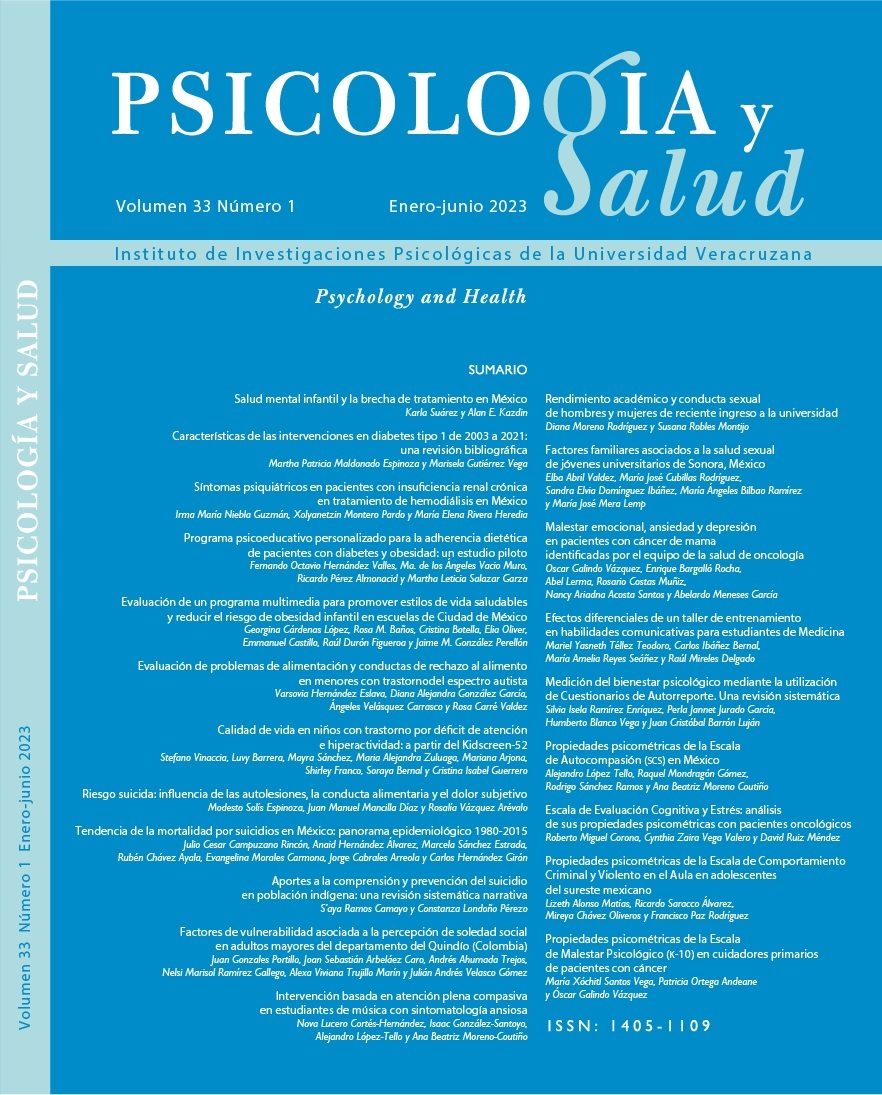Resumen
Objetivo. El objetivo del presente trabajo fue analizar la influencia de la conducta alimentaria de riesgo (CAR en lo sucesivo), las autolesiones y el dolor subjetivo en el riesgo suicida de adolescentes. Método. Se obtuvo por encuesta online una muestra de 423 mujeres, en quienes se evaluaron las CAR, el riesgo suicida, los síntomas depresivos y las autolesiones. Se efectuaron dos análisis de varianza de un factor y pruebas post hoc para analizar las diferencias entre grupos sin sintomatología, con autolesión, con CAR y con ambos problemas en riesgo suicida y sintomatología depresiva; asimismo, se verificaron dos análisis de varianza de un factor y pruebas post hoc para comparar grupos con diferente grado de dolor subjetivo tras autolesionarse. Resultados. El grupo comórbido y el de habituación al dolor reportaron puntuaciones más altas, pero no difirieron significativamente de los demás grupos. Conclusiones. Requieren especial atención los casos con comorbilidad, así como aquellos adolescentes con autolesión que pueden llegar a habituarse al dolor.
Citas
Ammerman, B.A., Burke, T.A., Alloy, L.B. y McCloskey, M.S. (2016). Subjective pain during NSSI as an active agent in suicide risk. Psychiatry Research, 236, 80-85. Doi: 10.1016/j.psychres.2015.12.028.
Beck, A.T., Steer, R.A., Ball, R. y Ranieri, W. (1996). Comparison of Beck Depression Inventory-IA and -II in psychiatric outpatients. Journal of Personality Assessment, 67, 588-597. Doi: 10.1207/s15327752jpa6703_13.
Brausch, A.M. y Perkins, N.M. (2018). Nonsuicidal self-injury and disordered eating: Differences in acquired capability and suicide attempt severity. Psychiatry Research, 266, 72-78. Doi: 10.1016/j.psychres.2018.05.021.
Chung, D.T., Ryan, C.J., Hadzi-Pavlovic, D., Singh, S.P., Stanton, C. y Large, M.M. (2017). Suicide rates after discharge from psychiatric facilities: a systematic review and meta-analysis. JAMA Psychiatry, 74(7), 694-702. Doi: 10.1001/jamapsychiatry.2017.1044.
Garner, D.M. y Garfinkel, P.E. (1979). The Eating Attitudes Test: An index of the symptoms of anorexia nervosa. Psychological Medicine, 9, 273-279. Doi: 10.1017/s0033291700030762.
Hasking, P., Lewis, S.P., Bloom, E., Brausch, A., Kaess, M. y Robinson, K. (2021). Impact of the COVID-19 pandemic on students at elevated risk of self-injury: The importance of virtual and online resources. School Psychology International, 42(1), 57-78. Doi: 10.1177%2F0143034320974414.
Hernández R., J. (2020). Impacto de la COVID-19 sobre la salud mental de las personas. Medicentro Electrónica, 24(3).
Hubers, A., Moaddine, S., Peersmann, S., Stijnen, T., van Duijn, E., van der Mast, R.C., Dekkers, O.M. y Giltay, E.J. (2018). Suicidal ideation and subsequent completed suicide in both psychiatric and non-psychiatric populations: a meta-analysis. Epidemiology and Psychiatric Sciences, 27(2), 186-198. Doi: 10.1017/S2045796016001049.
Islam, M.A., Steiger, H., Jiménez M., S., Israel, M., Granero, R., Agüera, Z., Castro, R., Sánchez, I., Riesco, N., Menchón, J.M. y Fernández A., F. (2015). Non-suicidal self-injury in different eating disorder types: relevance of personality traits and gender. European Eating Disorders Review, 23(6), 553-560. Doi: 10.1002/erv.2374.
Joiner, T. (2005). Why people die by suicide. Cambridge, MA: Harvard University Press.
Jurado, S., Villegas, M.E., Méndez, L., Rodríguez, F., Loperena, V. y Varela, R. (1998). La estandarización del Inventario de Depresión de Beck para los residentes de la Ciudad de México. Salud Mental, 21, 26-31.
Kostro, K., Lerman, J.B. y Attia, E. (2014). The current status of suicide and self-injury in eating disorders: a narrative review. Journal of Eating Disorders, 2(19), 1-9. Doi: 10.1186/s40337-014-0019-x.
Ma, J., Batterham, P.J., Calear, A.L. y Han, J. (2016). A systematic review of the predictions of the interpersonal-psychological theory of suicidal behavior. Clinical Psychology Review, 46, 34-45. Doi: 10.1016/j.cpr.2016.04.008.
O’Connor, R., Wetherall, K., Cleare, S., McClelland, H., Melson, A., Niedzwiedz, C. y Robb, K. (2020). Mental health and well-being during the COVID-19 pandemic: Longitudinal analyses of adults in the UK COVID-19 Mental Health y Wellbeing study. The British Journal of Psychiatry, 218(6), 326-333. Doi: 10.1192/bjp.2020.212.
Plutchick, R. y Van Praag, H. (1989). The measurement of suicidality, aggressivity and impulsivity. Progress in Neuro-Psychopharmacolology, Biology and Psychiatry, 6(13), 523-534. Doi: 10.1016/0278-5846(89)90107-3.
Prati, G. y Mancini, A.D. (2021). The psychological impact of COVID-19 pandemic lockdowns: A review and meta-analysis of longitudinal studies and natural experiments. Psychological Medicine, 51(2), 201-211. Doi: 10.1017/S0033291721000015.
Rubio, G., Montero, I., Jáuregui, J., Villanueva, R., Casado, M., Marín, J.J. y Santo-Domingo, J. (1998). Validación de la Escala de Riesgo Suicida de Plutchik en población española. Archivos de Neurobiología, 61(2), 143-152.
Smith, A.R., Ortiz, S.N., Forrest, L.N., Velkoff, E.A. y Dodd, D.R. (2018). Which comes first? An examination of associations and shared risk factors for eating disorders and suicidality. Current Psychiatry Reports, 20, 77. Doi: 10.1007/s11920-018-0931-x.
Sociedad Mexicana de Psicología (2007). Código ético del psicólogo (4a. ed.). México: Trillas.
Solís E., M. y Gómez-Peresmitré, G. (2020). Cuestionario de Riesgo de Autolesión (CRA): propiedades psicométricas y resultados en una muestra de adolescentes. Revista Digital Internacional de Psicología y Ciencia Social, 6(1). Doi: 10.22402/j.rdipycs.unam.6.1.2020.206.123-141.
Suárez C., Y., Palacio S., J., Caballero D., C.C. y Pineda R., C.A. (2019). Adaptación, validez de constructo y confiabilidad de la Escala de Riesgo Suicida de Plutchik en adolescentes colombianos. Revista Latinoamericana de Psicología, 51(3), 145-152. Doi: 10.14349/rlp.2019.v51.n3.1.
Svirko, E. y Hawton, K. (2007). Self-injurious behavior and eating disorders: the extent and nature of the association. Suicide & Life-threatening Behavior, 37(4), 409-421. Doi: 10.1521/suli.2007.37.4.409.
Taquet, M., Luciano, S., Geddes, J.R. y Harrison, P.J. (2021). Bidirectional associations between COVID-19 and psychiatric disorder: retrospective cohort studies of 62 354 COVID-19 cases in the USA. The Lancet Psychiatry, 8(2), 130-140. Doi: 10.1016/S2215-0366(20)30462-4.
Witte, T.K., Zuromski, K.L., Gauthier, J.M., Smith, A.R., Bartlett, M., Siegfried, N., Bodell, L. y Goodwin, N. (2016). Restrictive eating: Associated with suicide attempts, but not acquired capability in residential patients with eating disorders. Psychiatry Research, 235, 90-96. Doi: 10.1016/j.psychres.2015.11.043.

